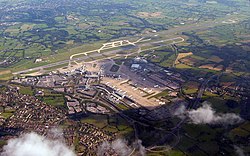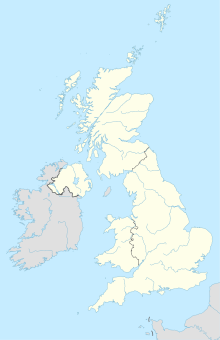
Back Manchester-lughawe Afrikaans مطار مانشستر Arabic مطار مانشستر ARZ Летище „Манчестър“ Bulgarian ম্যানচেস্টার বিমানবন্দর Bengali/Bangla Aeroport de Manchester Catalan Manchester Airport (tugpahanan sa Hiniusang Gingharian) CEB Letiště Manchester Czech Maes Awyr Manceinion Welsh Manchester Airport Danish
Manchester Airport | |||||||||||||||
|---|---|---|---|---|---|---|---|---|---|---|---|---|---|---|---|
 | |||||||||||||||
 | |||||||||||||||
| Summary | |||||||||||||||
| Airport type | Public | ||||||||||||||
| Owner/Operator | Manchester Airports Group | ||||||||||||||
| Serves | Greater Manchester | ||||||||||||||
| Location | Ringway, Manchester, England, United Kingdom | ||||||||||||||
| Opened | 25 June 1938 | ||||||||||||||
| Elevation AMSL | 257 ft / 78 m | ||||||||||||||
| Coordinates | 53°21′14″N 2°16′30″W / 53.35389°N 2.27500°W | ||||||||||||||
| Website | www | ||||||||||||||
| Map | |||||||||||||||
 | |||||||||||||||
| Runways | |||||||||||||||
| |||||||||||||||
| Statistics (2023) | |||||||||||||||
| |||||||||||||||
Sources: MAG Manchester Airports Group website, UK AIP at NATS[1] Statistics from the UK Civil Aviation Authority[2] | |||||||||||||||
Manchester Airport (IATA: MAN, ICAO: EGCC) is an international airport in Ringway, Manchester, England, 7 miles (11 km) south-west of Manchester city centre.[1][3] In 2022, it was the third busiest airport in the United Kingdom in terms of passengers (the busiest outside of London) and the 19th-busiest airport in Europe in 2023, with 28.1 million passengers served.[4]
The airport comprises a cargo terminal and three passenger terminals - although a £1.3 billion redevelopment programme will merge Terminals 1 and 2 in 2025. It covers an area of 560 hectares (1,400 acres) and has flights to 199 destinations, placing the airport thirteenth globally for total destinations served.[5]
Officially opened on 25 June 1938,[6] it was initially known as Ringway Airport, a name still in local use.[citation needed] In World War II, as RAF Ringway, it was a base for the Royal Air Force. The airport is owned and managed by Manchester Airports Group (MAG), a group owned by the ten metropolitan borough councils of Greater Manchester, with Manchester City Council owning the largest stake, and the Australian finance house IFM Investors. Ringway, after which the airport was named, is a village with a few buildings and a church at the western edge of the airport.
In 2017, an 8-year redevelopment programme commenced which will culminate with the merger of Terminals 1 and 2 to form one large terminal to better facilitate transfers.[7] The new terminal is due for completion in 2025 will take 80% of all passenger traffic.[8] Terminal 3 will remain with a focus on low-cost, short-haul airlines.
- ^ a b "Manchester – EGCC". Nats-uk.ead-it.com. Archived from the original on 1 February 2010. Retrieved 4 April 2010.
- ^ "Aircraft and passenger traffic data from UK airports". UK Civil Aviation Authority. 11 March 2017. Retrieved 11 March 2017.
- ^ "Live Search Maps". Microsoft.
- ^ "Strong December performance for UK's largest airports group sees MAG serve 60m passengers in 2023". Manchester Airports Group. 11 January 2024. Retrieved 11 January 2024.
- ^ "Frankfurt with almost 300 destinations and Paris CDG with over 100 airlines lead global analysis of airport operations in S17". anna aero. 15 February 2017. Retrieved 12 March 2017.
- ^ Scholefield 1998, p. 10
- ^ "Two years on Site | Manchester Airport Transformation Programme". Manchester Airport. 30 August 2019. Archived from the original on 1 November 2019. Retrieved 1 November 2019.
- ^ "One Year on Site". Manchester Airport. 17 August 2018. Archived from the original on 27 August 2018. Retrieved 27 August 2018.


